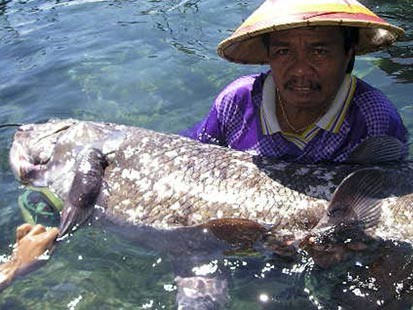tags: coelacanth, Latimeria menadoensis, fish, living fossil, Indonesia
Indonesian fisherman, Yustinus Lahama, holds up a coelacanth, an ancient fish once thought to have become extinct at the time of the dinosaurs, in a quarantine pool after he caught it in the sea off North Sulawesi province 19 May 2007.
Image: Stringer/Reuters
An Indonesian fisherman captured a coelacanth, Latimeria menadoensis, in the sea off North Sulawesi island near Bunaken National Marine Park in Indonesia. The coelacanth (pronounced SEE-la-kanth) is an ancient fish once thought to have become extinct at the time of the dinosaurs. The fisherman, Justinus Lahama, kept the fish at his house for an hour but after being told by neighbours that it was very rare, he returned it to the sea and kept it in a quarantine pool before it finally died.
"If kept outside their habitat (60 meters or 200 feet below the sea), the fish can only live for two hours. But this fish lived for about 17 hours," said Grevo Gerung, a professor at the fisheries faculty at the Sam Ratulangi University.
"The fish should have died within two hours because this species only lives in deep, cold-sea environment," agreed marine biologist Lucky Lumingas. Lumingas also works at the local Sam Ratulangi University, which plans to study the carcass.
The fish, which is inedible, was 131 centimetres (about four feet) long and weighed 51 kg (112 lb), Gerung said.
Bunaken National Marine Park has some of the highest levels of marine biodiversity in the world and is a popular diving spot for tourists.
In September 1997, fishermen a caught another specimen in a deep-water shark net off northern Sulawesi -- the first netted in Indonesia. That fish was captured 60 years after a sister species was first found on the east coast of South Africa, causing great excitement among the scientific world. Several other specimens have since been captured, including another off Sulawesi island in 1998.
Coelacanths are known as "living fossils" because they are found in the fossil record dating back more than 360 million years. They belong to a taxonomic order of fishes that include the oldest living lineage of jawed fish known to date. Before the first one was captured off the coast of South Africa in 1938, they were believed to have become extinct approximately 80 million years ago in the Cretaceous period, because they disappeared from the fossil record at that time
Modern coelacanths are blue colored fish with large white spots on their sides (see below). They have limb-like pectoral and anal fins supported by bones, and the tail or caudal fin is divided into three lobes, the middle one of which also includes a continuation of the notochord, which is a flexible, rod-shaped structure that served as the first backbone. Coelacanths are powerful opportunistic predators. They are the only living animals that have a fully functional intercranial joint, which is a physical barrier separating the front and back halves of the skull that possibly provides a flexure point that aid the fish as it eats oversized prey. Unlike most fish, coelacanths give birth to give birth to between 5 and 25 young live young (called pups) rather than laying eggs.
Sources
ABC News (quotes)
Yahoo News (quotes)



The coelacanth and the electric eel are the coolest fish.
amazing! Thanks for posting this...quite interesting. :o)
I believe these fish are sort of a "missing link" between fish and early amphibians.
Funnily enough, I was just re-reading Terry Pratchett's Thief of Time a few hours ago, which has a cute take on this...
Some background: Procrastinators are storage drums for time. Occasionally, there is more unattached time than can be stored, and something has to be done with it...
Why are they considered inedible?
I think they taste like leather. People had been catching Coelacanths for decades before they were recognized in 1938. They were almost always tossed overboard as soon as they were caught, and none of the locals saw the point of showing a big, nasty fish to a scientist.
they are considered inedible because they are mucid fishes -- secrete mucous, which is not very tasty.
I remember when we were doing our undergrad degree, one of our lecturers said that it was already extinct, but the in the 1940s (or something), it was found again.
And now they found it in Indonesia! Awesome..
i think that there is more than this fish that has been assumed to be extinct and actually not being so... the ocean is a vast place and its impossible to discover it all..